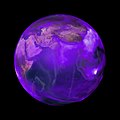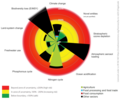Planetary boundaries
(Redirected from Freshwater cycle)
Planetary boundaries is a concept involving Earth system processes which contain environmental boundaries, proposed in 2009 by a group of Earth system and environmental scientists led by Johan Rockström from the Stockholm Resilience Centre and Will Steffen from the Australian National University. The group suggested that if human activity pushes the Earth system beyond these boundaries, there is a risk of "irreversible and abrupt environmental change". The concept evolved from an idea regarding the Holocene epoch, the relatively stable period of the last 11,700 years during which all human civilizations have developed.
Concept
The concept of planetary boundaries is based on the understanding that human actions can have disastrous impacts on Earth's ecosystem. The scientists identified nine planetary boundaries within which humanity can continue to develop and thrive for generations to come. Crossing these boundaries could generate abrupt or irreversible environmental changes. The nine boundaries are climate change, ocean acidification, stratospheric ozone depletion, nitrogen and phosphorus cycles, global freshwater use, change in land use, biodiversity loss, atmospheric aerosol loading, and chemical pollution.
Planetary Boundaries
Climate Change
Climate change is one of the most critical planetary boundaries. It refers to the long-term alteration in average weather patterns, especially a rise in global temperatures. The boundary is defined by the concentration of carbon dioxide in the atmosphere and the change in average global surface temperature.
Ocean Acidification
Ocean acidification is a decrease in the pH of the Earth's oceans, caused by the uptake of carbon dioxide from the atmosphere. This process makes the ocean more acidic, which can harm marine life, particularly organisms with calcium carbonate shells.
Stratospheric Ozone Depletion
Stratospheric ozone depletion is the reduction of ozone in the stratosphere due to the release of ozone-depleting substances. The boundary is defined by the concentration of ozone-depleting substances in the stratosphere and the size of the Antarctic ozone hole.
Nitrogen and Phosphorus Cycles
The nitrogen cycle and the phosphorus cycle are two of the most important nutrient cycles in terrestrial ecosystems. They are essential for the production of amino acids and nucleic acids, which are the building blocks of life. The boundary is defined by the amount of nitrogen removed from the atmosphere for human use and the quantity of phosphorus flowing into the oceans.
Global Freshwater Use
Global freshwater use refers to the total volume of water used by humans from freshwater sources. The boundary is defined by the global consumption of freshwater.
Change in Land Use
Change in land use involves the alteration of the purpose for which land is used by humans. The boundary is defined by the percentage of global forest cover.
Biodiversity Loss
Biodiversity loss is the decrease in the variety of life forms on Earth. The boundary is defined by the extinction rate.
Atmospheric Aerosol Loading
Atmospheric aerosol loading refers to the amount of solid particles or liquid droplets suspended in the air. The boundary is defined by the overall effect of aerosols on the Earth's climate system.
Chemical Pollution
Chemical pollution involves the introduction of harmful substances into the environment. The boundary is defined by the concentration of pollutants, plastics, heavy metals, and radioactive substances in the environment.
See Also
This article is a environment-related stub. You can help WikiMD by expanding it!
Transform your life with W8MD's budget GLP-1 injections from $125.
W8MD offers a medical weight loss program to lose weight in Philadelphia. Our physician-supervised medical weight loss provides:
- Most insurances accepted or discounted self-pay rates. We will obtain insurance prior authorizations if needed.
- Generic GLP1 weight loss injections from $125 for the starting dose.
- Also offer prescription weight loss medications including Phentermine, Qsymia, Diethylpropion, Contrave etc.
NYC weight loss doctor appointments
Start your NYC weight loss journey today at our NYC medical weight loss and Philadelphia medical weight loss clinics.
- Call 718-946-5500 to lose weight in NYC or for medical weight loss in Philadelphia 215-676-2334.
- Tags:NYC medical weight loss, Philadelphia lose weight Zepbound NYC, Budget GLP1 weight loss injections, Wegovy Philadelphia, Wegovy NYC, Philadelphia medical weight loss, Brookly weight loss and Wegovy NYC
|
WikiMD's Wellness Encyclopedia |
| Let Food Be Thy Medicine Medicine Thy Food - Hippocrates |
Medical Disclaimer: WikiMD is not a substitute for professional medical advice. The information on WikiMD is provided as an information resource only, may be incorrect, outdated or misleading, and is not to be used or relied on for any diagnostic or treatment purposes. Please consult your health care provider before making any healthcare decisions or for guidance about a specific medical condition. WikiMD expressly disclaims responsibility, and shall have no liability, for any damages, loss, injury, or liability whatsoever suffered as a result of your reliance on the information contained in this site. By visiting this site you agree to the foregoing terms and conditions, which may from time to time be changed or supplemented by WikiMD. If you do not agree to the foregoing terms and conditions, you should not enter or use this site. See full disclaimer.
Credits:Most images are courtesy of Wikimedia commons, and templates, categories Wikipedia, licensed under CC BY SA or similar.
Contributors: Prab R. Tumpati, MD







